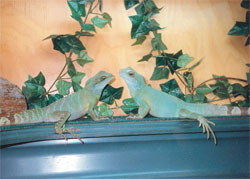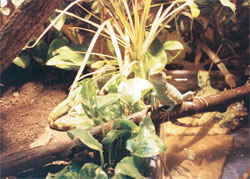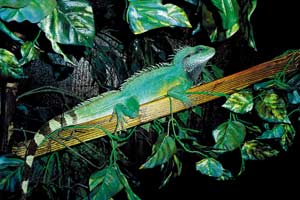The Chinese water dragon is perfect for those who want a beautiful reptile for a tropical vivarium.
I developed a passion for water dragons in 1995 when I first saw a gorgeous green lizard with bright golden-brown eyes staring back at me through its tank in a local pet store. I had kept many other reptile and amphibian species in the past, but never lizards. Little did I know that upon setting eyes on that bright green creature that it would become the start of what appears to be a life-long love of the green water dragon.
Chinese water dragons (Physignathus cocincinus) were starting to become popular in the pet trade at that time, but it wasn’t as easy to find quality care information in 1995 as it is today. Over the past decade, I have researched the care of Physignathus cocincinus by reading books, exchanging information with thousands of water dragon owners and through my own trial and error.

Photo by Tricia Power
Know the sex of your water dragons before placing multiple individuals in an enclosure together. More than one male may result in battles.
Stores that sell reptiles often carry Chinese water dragons, also known as the green water dragon or Asian water dragon. They originate from the southeast Asian mainland — Thailand, southern China, Vietnam and Cambodia. Many of these lizards are still imported from their countries of origin for the pet trade, but over the years there has been an increase in captive breeding by private owners and reptile-related businesses throughout North America and Europe. Try to find a captive-bred Asian water dragon when considering a purchase, as your new lizard will likely be healthier and less stressed than its wild-caught or imported counterpart.
Given optimal care, green water dragons can live up to 16 years. I have found them to be extremely pleasant to care for. They are beautiful to observe given their attractive bright green color, and once they are used to your presence, they are generally tame and easily handled. While they occasionally fight among themselves or compete for superiority with cagemates, they are rarely aggressive toward human keepers. If frightened, they might give you an open-mouthed threat, which they rarely follow through on, or a light tail whip when picked up. If scared, they may turn dark or try to hide behind a plant or in their water.
Chinese Water Dragon Hatchlings
Hatchlings are 1 inch snout to vent, and 5 to 6 inches in total length. The upper surfaces of their body are a brownish green, while a pale green to white covers their lower abdominal area. Light-colored stripes of white or beige run vertically on either side of the body, and a brown and green banded tail, very large eyes and short snout make up the rest of their features. After growing to approximately 10 inches, and after shedding their skin a few times, the upper body becomes a bright green, ranging from aqua to mint green.
Adult males grow to approximately 3 feet in length; adult females measure approximately 2 feet. The tail is laterally flattened, banded brown and green, ends in a fine point and makes up 70 to 75 percent of their length. Water dragons use their tails for balance and leverage when climbing, and they can use them to whip would-be attackers, predators or keepers.

Photo by Tricia Power
Water dragons like a humid environment. Water in the enclosure, as well as live plants and a soil substrate, can all increase humidity.
Adult water dragons are, of course, green, ranging from a dark forest green to a light mint green. The lower body is generally white or a very light yellow, while the vertical stripes that run along the sides of the water dragon’s body are a pale green, mint green, aqua or even turquoise in color. The throats of juvenile and adult water dragons can also be quite colorful, ranging from a very pale yellow, orange, peach, bright pink, fuchsia or even dark purple.
The head is triangular, and a male’s will become quite large and wide. Large, rounded, white scales run just below the mouth and end in one or two larger pointed scales where the head and neck meet. A dark stripe runs from the lower corner of the eye and toward the ear. The tongue is thick and wide, and ends in a very small fork. It has a sticky surface that helps to catch and hold prey. Water dragon teeth are small and pointed — the better to eat an omnivorous diet — and can draw blood if a dragon were to bite its keeper. Luckily, most dragons are even-tempered and rarely bite.
Both males and females have well-developed nuchal crests above the neck; however, an adult male’s is often higher and has longer spikes. Males also have prominent mid-sagittal crests. A very small round shiny “scale,” located on the top of the head between the eyes, is known as the parietal or third eye. The parietal eye is thought to help water dragons, as well as a number of other reptiles, sense differences in light. It is believed they use it to help thermoregulate. For example, it may help them to decide upon a good basking spot, or it may sense decreasing light levels, leading to a lizard finding shelter for the night.

Photo by Tricia Power
Because they are arboreal, water dragons need branches and other climbing areas inside their enclosures.
Water dragons have well-developed legs; the front legs are generally much more slender than the back legs. The front legs climb and grasp branches, while the muscular back legs aid in climbing and swimming, as well as jumping or leaping. Water dragons can run on their strong hind legs, which is an amazing sight to see. The front and hind feet are five-toed, and the middle toes on the hind feet are the longest.
Almost all green water dragons appear female until they attain 14 to 16 inches in length, at which time males begin to develop larger heads, jowls and a higher nuchal crest. The femoral pores of adult males are slightly larger than that of the females too. When dragons are mature and able to breed, they are generally about 2 years old and 2 feet long.
Knowing the sex of your water dragon is important if you want to keep more than one in the same enclosure. Two mature males will fight, and these fights can often result in serious injury or even death. Two female dragons usually get along but they, too, can become territorial. When housing multiple dragons in one large enclosure, I’ve found that the best mix is one male to two or three females.
If keeping more than one dragon interests you, I strongly suggest keeping an additional enclosure set up and ready for use in the event that your pets fight or if one falls ill. It will be easier for you to care for one that is not doing well if you can separate it from the other dragons. In cases of illness it might even help prevent an infection from spreading into the remainder of your collection.
Chinese Water Dragon Enclosure
Caring for Chinese water dragons is not all that difficult but their needs are very specific (as are most reptile species’). They are arboreal lizards, meaning they climb and like to be up high. An ideal enclosure for one or more adult dragons would measure 6 feet tall, 3 to 4 feet deep and 4 to 6 feet long.
Water dragons enjoy a humid environment, so maintain cage humidity at close to 80 percent. Unless you live in a warm, humid climate, a screened enclosure will not be suitable for maintaining the needed heat and humidity range for your water dragon. If you build an enclosure for your pet dragon, think about making it out of wood or glass. However, keep in mind that water dragons don’t seem to understand glass and often end up rubbing their snouts on glass walls, often permanently damaging their noses and lower jaws. If the enclosure is large, damage from snout rubbing seems to be less of a problem. You can also try taping a visual barrier (such as paper or cardboard) around the outside bottom of the enclosure, so the water dragons can’t see through. This reportedly can curb snout rubbing as well.
Green water dragons enjoy swimming and soaking in water. Provide a large pan that’s deep enough to allow soaking (hatchlings do fine a with shallow pan). Change the water frequently to maintain cleanliness. If you choose to build an elaborate naturalistic vivarium complete with a pool for your water dragons, consider using some type of aquarium filter in the water area.
I do stress that any water area be kept clean. Chinese water dragons are susceptible to Pseudomonas infections and often pick these up in water areas that have not been well maintained. Nonfiltered water areas need cleaning once a day, and filtered water areas should have a complete water change and cleaning no less than every three or four days.
Maintaining cage humidity can be difficult. Enclosed cages, those built with glass or wood, with sliding doors and solid lids often easily maintain humidity at the proper levels. Open-topped glass tanks and screened cages pose more difficulty.
I find that along with heat (more on this later), moving water in the cage helps increase humidity. You may use something simple, such as an air-stone bubbler placed in the water, or create an impressive waterfall using an aquarium powerhead. Live plants and substrates that hold moisture also help increase cage humidity, as does misting the cage once or twice a day with a spray bottle.
As arboreal creatures, water dragons need some high basking areas in the cage to rest in. Climbing branches or shelves within the enclosure will allow them to reach the upper limits of the cage. Live or artificial plants and leafy green foliage throughout the enclosure provide shelter and will make your water dragon feel more secure in its environment. If you choose to use live plants you might try Dracaena, hibiscus and ficus bushes, Pothos, Philodendron and spider plant. Epiphytes such as staghorn ferns can be used too, as well as some bromeliads.
Your choice of substrate also helps maintain cage humidity. There are a variety of substrates to choose from, but my favorite is plain, sterile soil. It can be dug in if a female is gravid, it can help live plants grow, it’s soft for jumping dragons to land on and it helps maintain cage humidity if kept slightly moist. Many water dragon owners also use astroturf or repti-carpet, as these can be easily replaced with a clean piece when soiled (beware unraveling edges that can snag lizard toes). Large pieces of orchid and cypress bark work if the bark is larger than the water dragon’s head; otherwise, they tend to accidentally eat bark and other loose substrates, which poses the risk of bowel obstruction. Substrates that are composed of coconut husk may cause eye irritation that can lead to infection in water dragons.
Daytime temperatures should range from 84 to 88 degrees Fahrenheit, with a basking area of 95. Nighttime temperatures should range from 75 to 80 degrees. It’s a good idea to have at least two thermometers in the cage, one in the cool side and one in the warm side of the enclosure. Improper temperature ranges can lead to a water dragon with a weakened immune system and inadequate digestion of nutrients due to slower metabolism.
Natural, unfiltered sunlight is the very best lighting for water dragons and most other herps. Unfortunately, many people who own water dragons cannot provide natural sunlight at all. If you can, by all means do so, especially if you can build an outdoor wire cage with plants and foliage for shelter, shade and security. Never put a glass tank that contains a dragon — whether it’s indoors or outside — in direct sunlight, as this could cause severe overheating and death.
Chinese Water Dragon Lighting Information
You will need to provide UVB in the form of fluorescent or metal halide lighting. Incandescent bulbs do not produce UVB rays; they usually only provide UVA. Your water dragon will need UVB to produce vitamin D3 in its skin, which in turn aids it in using the calcium in its diet properly. Without proper UVB lighting, water dragons often develop nutritional secondary hyperparathyroidism (aka metabolic bone disease), which causes their bones to soften, bend and break easily. It can also lead to tremors, seizures and even death if action isn’t taken to reverse the deficiency.
Set UVB lighting fixtures over your dragon’s basking area. There should not be glass or plastic between the light and the dragon as this will block most of the UVB rays from reaching your lizard. The light should also sit no more than 10 to 12 inches above your dragon to provide the highest level of UVB.
Incandescent basking lights can maintain proper cage temperatures, and their heat combined with misting helps maintain humidity. Water dragons are diurnal lizards, meaning they are active during the day and sleep at night. The lights, therefore, need to go off at night. For this reason, a lightless heat source, such as a ceramic heat emitter for day and night heating might also prove beneficial. Set the ceramic heat emitter on a thermostat or rheostat control to maintain the needed temperature range. Your water dragon should have light during normal seasonal daylight hours. I use a timer to create a day/night cycle; it turns the lights on at 7 a.m. and turns them off near sunset, perhaps 7 p.m.
Chinese Water Dragon Food
Chinese water dragons eat a variety of live food items ranging from crickets, mealworms, king mealworms, waxworms, earthworms, grasshoppers, butterworms, locusts, feeder fish, pinkies and fuzzies. Many care booklets say that water dragons eat some fruit and vegetables. You may try to offer finely shredded vegetables and small chunks of fruit, but these items should make up only about 10 to 15 percent of your dragon’s diet if you are able to get it to eat them. I have never been successful in my attempts, but I have spoken with many people who have been.
I always feed my dragons daily. Some literature suggests feeding them every second or third day, but I’ve never felt comfortable with that schedule, especially for hatchling and young dragons. They are growing and need their nutrients. Hatchling and very young dragons can eat most of the food items listed above with the exception of pinkies and fuzzies. Their food items need to be small — 2-week-old crickets, small mealworms or earthworms broken into two or three pieces.
Water dragons can become picky eaters and may refuse to eat when they become bored with their food. This happens most often when an owner only feeds perhaps two types of food items most of the time. One way to combat boredom is to vary the diet by offering crickets one day, mealworms the next, earthworms the day after that and so on. We would get bored if we ate the same thing every day, so why shouldn’t they?
Whole prey items, such as pinkies, fuzzies and feeder fish, are an important component of a juvenile-to-adult water dragon’s diet. These items are high in calcium and other nutrients, and if offered to the dragon two or three times a week will help maintain a good bone structure.
Chinese water dragons are not the easiest reptile to care for, but in my opinion, they certainly are one of the most beautiful and worth any extra effort.



